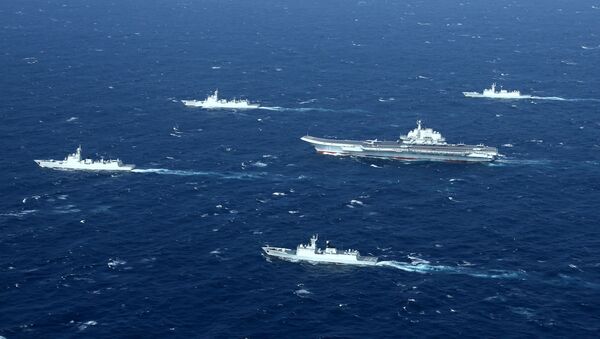Washington is intensifying its military pressure on Beijing amid growing tensions over the South China Sea as the White House accuses Chinese authorities of exploiting the coronavirus pandemic in order to strengthen their regional clout.
US Navy Captain Michael Kafka, a spokesperson for the American military's Indo-Pacific Command, told CNN that "the People's Republic of China is attempting to use the regional focus on COVID [-19] to assertively advance its own interests".
On the South China Sea, Kafka pledged that the US would continue to conduct a "global Freedom of Navigation operations programme in which US Navy ships safely and professionally challenge excessive maritime claims, including those" in the area.
He recalled that the US is also going ahead with "routine transits through the Taiwan Strait to further demonstrate that the United States will fly, sail, and operate anywhere that international law allows".
The statement was made as a Pentagon official underlined that the coronavirus outbreak would not prevent the US military from responding to Chinese actions.
"We have the capability and capacity to provide long range fires anywhere, anytime and can bring overwhelming firepower, even during the pandemic", according to General Timothy Ray, commander of the Air Force Global Strike command which oversees the bomber force in the area.
The US Navy Pacific Fleet, in turn, announced on Wednesday that all of its submarines in the area were at sea to carry out operations "in support of a free and open Indo-Pacific region amidst the pandemic caused by the coronavirus".
This was echoed by Pentagon spokesman Dave Eastburn who told CNN that the US Department of Defence is concerned over China’s "increasing, opportunistic activity to coerce its neighbours and press its unlawful maritime claims in the South China Sea, while the region and the world is focused on addressing the COVID-19 pandemic".
The view was backed by Admiral John Aquilino, the commander of the US Pacific Fleet, who underscored the American military’s adherence to "a rules-based order in the South China Sea" and determination to "continue to champion freedom of the seas and the rule of law".
Li Huamin, spokesperson for the Chinese People's Liberation Army Southern Theatre Command, responded by urging the US to concentrate on "its own business with pandemic prevention and control, make more contributions to the global fight against COVID-19, and immediately stop military operations that are detrimental to regional security, peace, and stability".
The remarks were preceded by the US Air Force (USAF) saying in a statement late last month that two USAF B-1B Lancer bombers had made a 32-hour round-trip flight from South Dakota "to conduct operations over the South China Sea" as part of a bomber task force mission.
"This operation demonstrates the US Air Force’s dynamic force employment model in line with the National Defence Strategy’s objectives of strategic predictability with persistent bomber presence, assuring allies and partners", the statement pointed out at the time.

Apart from Beijing, the Spratly Islands and Paracel Islands, which are among the more frequently disputed South China Sea territories, are also claimed by the Philippines, Vietnam, Brunei, Malaysia, and Taiwan. The US has no claims to the territories, but it has repeatedly sent its military vessels to the South China Sea to fulfil "freedom of navigation" missions, slammed by Beijing as "provocations".
President Donald Trump on Thursday announced that the US could completely cut off diplomatic relations with China over the ongoing coronavirus crisis and save at least half a trillion dollars by doing so. This came as POTUS floats the idea of imposing tariffs against Beijing as a response to its so-called mishandling of the novel coronavirus which Trump earlier claimed originated in a Chinese biolab.
Beijing has repeatedly rejected the allegations, with Chinese Foreign Ministry spokesperson Hua Chunying calling on the US last month to "handle its domestic affairs properly first", rather than attempt to shift blame and focus onto China.





